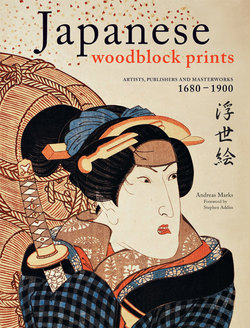Читать книгу Japanese Woodblock Prints - Andreas Marks - Страница 23
На сайте Литреса книга снята с продажи.
ОглавлениеShunshō
1726–1793
Given names: Yōsuke, Yūsuke (from 1774). Art surname: Katsukawa. Art names on paintings: Jūgasei, Kyokurōsai, Kyokurōsei, Ririn, Rokurokuan, Yūji. Jar-shaped seal with the character “rin” (grove).
Born presumably in 1726, Shunshō initially studied painting under Katsukawa Shunsui (act. c.1744–64) and the Hanabusa school painter Kō Sūkoku (1730–1804). His earliest known prints date from 1764 when he was nearly forty years old. Together with Bunchō he played the central role in the development of realistic portrayal of actors. Most important are their illustrations in the book “A Picture-book of Stage Fans” (Ehon butai ōgi) from 1770. The novel half-length portraits of actors in fan shapes was an approach that was continued by Shunshō in his celebrated series “Fans of the East” (Azuma ōgi: 1775–82).
After Bunchō ceased to design actor prints in the 1770s, Shunshō became pre-eminent in this field, providing more realistic portraits that emphasize the individual characters of the actors. Overall, he designed several hundred actor prints in the small, narrow hosoban format, sometimes composed as diptychs, triptychs, or even pentaptychs.
Shunshō was active in other genres as well, working for at least 18 different publishers. His early beauties like the series “Eight Views of Fukagawa” (Fukagawa hakkei) are strongly influenced by Harunobu. Around 1772 he collaborated with Shigemasa in producing the chūban-size series “Silkworm Cultivation” (Kaiko yashinai gusa). From c.1772–73 date forty-eight chūban-format designs of the first full-color print series illustrating the “Tales of Ise” (Ise monogatari). At the top of each print is a stylized cloud border, enclosing the poem from the depicted episode.
Shunshō created several portraits of sumo wrestlers. Until his death, Shunshō continued to illustrate books and also produced several erotica. In 1776, again in collaboration with Shigemasa, he illustrated the book “Mirror of Competing Beauties of the Green Houses” (Seirō bijin awase sugata kagami). Of the more than one hundred paintings known by him, the earliest is dated to c.1779–80. As head of the Katsukawa school, Shunshō had many students, including Shunkō, Shun’ei, Shunzan, Shundō, and Shunrō (who later changed his name to Katsushika Hokusai).
Shunshō passed away aged 67 on the eighth day of the twelfth month 1792, which corresponds to January 19, 1793 in the modern calendar. He is burried at Matsudaira Saifukuji, Asakusa, today located in Tokyo’s Taitō ward.
Early 1770s The actors Nakamura Sukegorō II and Segawa Kikunojō II in unidentified roles. Hosoban nishiki-e. Asian Art Museum, National Museums in Berlin.
1768 The actors ōtani Hiroji III as Kameō and Sakata Sajūrō I as Ariō in the play Hime Komatsu ne no hi no asobi, Ichimura Theater, IX/1768. Hosoban nishiki-e. Asian Art Museum, National Museums in Berlin.
c.1772–73 “The Syllable Yo”, from the series “Tales of Ise in Fashionable Brocade Prints” (Fūryū nishiki-e Ise monogatari). Chūban. Collection Peter Rieder.
late 1770s The actor Nakamura Rikō I in an unidentified role. (Left sheet of a diptych, right sheet shows the actor ōtani Tomoemon I). Hosoban nishiki-e. Asian Art Museum, National Museums in Berlin.
1770 The actor Ichikawa Danzō IV, from the “Picture-book of Stage Fans” (Ehon butai ōgi), vol. 2, p. 19. 16.7 x 25.9 cm (6.6 x 10.2 in.). Publisher: Kariganeya Ihei. Library of Congress.
c.1786 West Division—The sumo wrestlers Sekinoto Hachirōji and Dewanoumi Kinzō. Ōban. Collection Peter Rieder.
1776 The actor Ichikawa Danjūrō V as the spirit of the old woman Higaki in the play Sugata no hana yuki no kuronushi, Ichimura Theater, XI/1776. Hosoban nishiki-e. Asian Art Museum, National Museums in Berlin.
c.1770s The actors Nakamura Tomijūrō I sitting on a horse and Bandō Mitsugorō I in an unidentified play. Hosoban nishiki-e. Asian Art Museum, National Museums in Berlin.
c.1770s “Autumn Moon at Shiohama” (Shiohama no aki no tsuki), from the series “Eight Views of Fukagawa” (Fukagawa hakkei). Chūban. Collection Peter Rieder.
